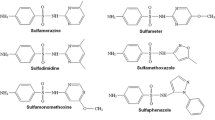Abstract
An efficient extraction of sulfadiazine residues from soils is difficult, as sulfadiazine is known to form quickly sequestering residues. The objective of this study was to optimize an exhaustive extraction for aged residues of sulfadiazine and its two major metabolites, N-acetylsulfadiazine and 4-hydroxysulfadiazine, from soil. For this purpose two representative used agricultural soils (Luvisol, Cambisol) were blended with manure derived from [14C]sulfadiazine-treated pigs and incubated at 10 °C in the laboratory. After different extraction tests with various solvent mixtures (two- to four-component mixtures with water, methanol, acetonitrile, acetone, and/or ethyl acetate), different pH values (pH 4 and 9), and extraction temperatures (up to 200 °C), soil extracts were measured by liquid scintillation counting and liquid chromatography coupled to tandem mass spectrometry. With respect to sulfadiazine yields, stability of soil extracts, and the amount of coextracted matrix, a microwave extraction of soil (15 min, 150 °C) using acetonitrile/water 1:4 (v/v) is the method of choice for the exhaustive extraction of aged sulfadiazine residues from soils.

Similar content being viewed by others
References
Campbell KL (1999) Vet Dermatol 10:205–215
Lamshöft M, Sukul P, Zühlke S, Spiteller M (2007) Anal Bioanal Chem 388:1733–1745
Halling-Sørensen B, Nielsen SN, Lanzky PF, Ingerslev F, Lützhøft HCH, Jørgensen SE (1998) Chemosphere 36:357–394
Jørgensen SE, Halling-Sørensen B (2000) Chemosphere 40:691–699
Kümmerer K (2003) J Antimicrob Chemoth 52:5–7
Kotzerke A, Sharma S, Schauss K, Heuer H, Thiele-Bruhn S, Smalla K, Wilke BM, Schloter M (2007) Environ Pollut. DOI 10.1016/j.envpol.2007.08.020 (in press)
Hammesfahr U, Heuer H, Manzke B, Smalla K, Thiele-Bruhn S (2007) Soil Biol Biochem (in press)
Teuber M (2001) Curr Opin Microbiol 4:493–499
Kümmerer K (2004) J Antimicrob Chemoth 54:311–320
Kreuzig R, Höltge S (2005) Environ Toxicol Chem 24:771–776
Blackwell PA, Kay P, Boxall ABA (2007) Chemosphere 67:292–299
Accinelli C, Koskinen WC, Becker JM, Sadowsky MJ (2007) J Agric Food Chem 55:2677–2682
Schmidt B, Ebert J, Lamshöft M, Thiede B, Schumacher-Buffel R, Rong J, Corvini P, Schäffer AJ (2008) Environ Sci Health B 43:8–20
Stoob K, Singer HP, Stettler S, Hartmann N, Mueller SR, Stamm CH (2006) J Chromatogr A 1128:1–9
Burkhardt M, Stamm C (2007) J Environ Qual 36:588–596
Haller MY, Müller SR, McArdell CS, Alder AC, Suter MJF (2002) J Chromatogr A 952:111–120
Hamscher G, Pawelzick HT, Hoper H, Nau H (2005) Environ Toxicol Chem 24:861–868
Alexander M (2000) Environ Sci Technol 34:4259–4265
Gevao B, Semple KT, Jones KC (2000) Environ Pollut 108:3–14
Laabs V, Amelung W (2005) J Agric Food Chem 53:7184–7192
Laabs V, Amelung W, Zech W (1999) J Environ Qual 28:1778–1786
Golet EM, Strehler A, Alder AC, Giger W (2002) Anal Chem 74:5455–5462
Huang L, Pignatello J (1990) J Assoc Off Anal Chem 73:443–446
Amelung W, Nikolakis A, Laabs V (2007) J AOAC Int 90:1959–1969
Ismail LI, Hawash S, El Diwani GI (1987) Egypt J Chem 30:457–466
Thiele-Bruhn S, Seibicke T, Schulten HR, Leinweber P (2004) J Environ Qual 33:1331–1342
FAO (2006) World reference base for soil resources. World soil resources reports no 103. Food and Agriculture Organization of the United Nations, Rome
Sakurai H, Ishimitsu T (1980) Talanta 27:293–298
Sparks DL (2003) Environmental soil chemistry. Academic, San Diego
Hartmann N (2003) An extraction method to determine sulfonamide antibiotics in soil. ETH, Zurich Zurich
Kay P, Blackwell PA, Boxall ABA (2005) Chemosphere 60:497–507
Schnitzer M (1991) Soil Sci 151:41–58
Richter BE, Jones BA, Ezzell JL, Porter NL, Avdalovic N, Pohl C (1996) Anal Chem 68:1033–1039
Kahle M, Stamm C (2007) Environ Sci Technol 41:132–138
Srogi K (2006) Anal Lett 39:1261–1288
Camel V (2000) Trac-Trends Anal Chem 19:229–248
Pignatello J, Xing B (1996) Environ Sci Technol 30:1–11
Acknowledgments
We thank Ursula Kutsch for her help with laboratory analyses of soil samples, Dr. Mort Canty for proofreading our manuscript, and Bayer CropScience AG for conducting the radioactive sulfadiazine medication experiment. The project was funded by the German Research Foundation (DFG) within the Research Unit FOR566 “Veterinary medicines in soils: Basic research for risk assessment” (AM134/6–2).
Author information
Authors and Affiliations
Corresponding author
Rights and permissions
About this article
Cite this article
Förster, M., Laabs, V., Lamshöft, M. et al. Analysis of aged sulfadiazine residues in soils using microwave extraction and liquid chromatography tandem mass spectrometry. Anal Bioanal Chem 391, 1029–1038 (2008). https://doi.org/10.1007/s00216-008-2081-1
Received:
Revised:
Accepted:
Published:
Issue Date:
DOI: https://doi.org/10.1007/s00216-008-2081-1




